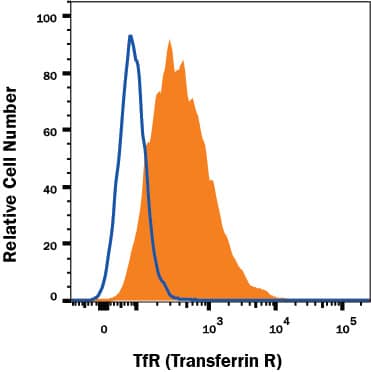Rat TfR (Transferrin R) Antibody
R&D Systems, part of Bio-Techne | Catalog # MAB10079


Key Product Details
Species Reactivity
Applications
Label
Antibody Source
Product Specifications
Immunogen
Specificity
Clonality
Host
Isotype
Scientific Data Images for Rat TfR (Transferrin R) Antibody
Detection of TfR (Transferrin R) in PC‑12 Rat Cell Line by Flow Cytometry.
PC-12 rat adrenal pheochromocytoma cell line was stained with Mouse Anti-Rat TfR (Transferrin R) Monoclonal Antibody (Catalog # MAB10079, filled histogram) or isotype control antibody (Catalog # MAB003, open histogram) followed by Goat anti-Mouse IgG PE-conjugated secondary antibody (Catalog # F0102B). View our protocol for Staining Membrane-associated Proteins.Applications for Rat TfR (Transferrin R) Antibody
CyTOF-ready
Flow Cytometry
Sample: PC‑12 rat adrenal pheochromocytoma cell line
Formulation, Preparation, and Storage
Purification
Reconstitution
Formulation
Shipping
Stability & Storage
- 12 months from date of receipt, -20 to -70 °C as supplied.
- 1 month, 2 to 8 °C under sterile conditions after reconstitution.
- 6 months, -20 to -70 °C under sterile conditions after reconstitution.
Background: TfR (Transferrin R)
The Transferrin Receptor (TfR or TfR-1, designated CD71) is a type 2 transmembrane glycoprotein expressed on erythroid progenitors, muscle cells and proliferating cells as a 188 kDa disulfide-linked homodimer of 95 kDa monomers. As the major mediator of cellular iron uptake, it binds and internalizes diferric transferrin, allowing iron release at the low pH of the endosome. Most soluble TfR (sTfR) arises from trypsin proteolysis at aa 100, producing the circulating form of TfR. sTfR concentration in plasma or serum is proportional to total TfR and can be increased by iron deficiency. Erythroid progenitors, which use iron for hemoglobin synthesis, normally account for the bulk of total body TfR production. Since rapidly growing cells require iron to replicate DNA, cancer cells can express up to 5-fold more TfR than quiescent cells in the surrounding tissue. Antibody targeting of TfR can inhibit tumor cell proliferation and induce apoptosis. The hereditary hemochromatosis protein HFE competes with diferric transferrin for binding to TfR, and targets TfR for degradation rather than recycling. TfR has been reported to have ferritin-independent functions in T cell development, immunological synapse formation and galectin-3-mediated cell death, and to be a cell entry receptor for New World hemorrhagic fever arenaviruses.
Long Name
Alternate Names
Gene Symbol
Additional TfR (Transferrin R) Products
Product Documents for Rat TfR (Transferrin R) Antibody
Product Specific Notices for Rat TfR (Transferrin R) Antibody
For research use only